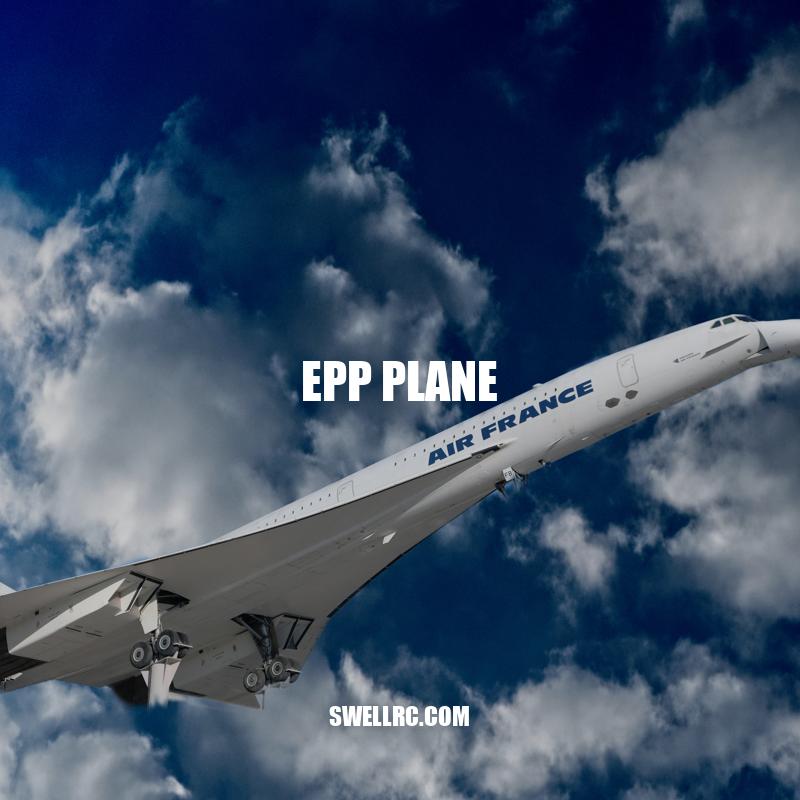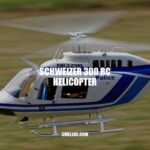Building and Flying with EPP Foam Planes: A Guide for RC Enthusiasts
EPP (Expanded Polypropylene) foam planes are the new sensation in the world of radio-controlled planes. This material’s unique properties allow pilots to perform acrobatic and aerobatic maneuvers with ease and without the fear of damaging the plane. EPP foam planes are ideal for beginners, who are still learning how to fly, as they are more forgiving when it comes to crashes. EPP foam is incredibly resilient, and it can easily absorb high impacts, making the planes almost indestructible. This makes them great for those looking to learn how to fly without breaking the bank. Additionally, EPP foam planes are incredibly lightweight, providing pilots with a smooth and responsive flying experience. The foam material is also an excellent insulator, which means EPP planes can retain heat in cold weather, allowing for longer flights. These advantages have made EPP planes incredibly popular among the RC community. With features that help build pilot skills and mechanisms that ensure proper durability, EPP foam planes provide an excellent opportunity for those looking to enter or upgrade their RC plane experience.
Advantages of EPP Planes
EPP foam planes have a ton of advantages that make them an excellent choice for both beginners and advanced RC pilots. Here are a few of the top benefits:
- Impact-resistant: EPP foam planes can easily withstand crashes, collisions, and other impacts, making them ideal for beginners who may make mistakes during flying.
- Lightweight: The foam material is incredibly light, which makes EPP planes easy to maneuver and responsive to control inputs.
- Insulation: EPP foam is a great insulator, which helps keep the internal electronic components warm and functioning correctly, even in cold weather.
- Customization: The relatively low cost of the foam material makes EPP planes a great starting point for those looking to customize their planes. Pilots can easily add cameras, sensors, LEDs, and other accessories to enhance their flying experience.
- Affordability: Compared to other plane-building materials, EPP foam is significantly less expensive. This makes EPP planes an ideal option for those looking for an affordable way to enter the RC plane community.
Some popular EPP planes include the Riot EPP Foam RC Trainer Plane, the RC Factory Mini Edge 540, and the VAS Banshee EPP combat wing. These planes offer various flying experiences, from sport flying to high acrobatic performance. Additionally, RC enthusiasts can purchase EPP foam and building templates to build their planes, adding even more customization options.
What is the difference between EPO and EPP foam?
Foam is a popular material in various industries because of its lightweight and durability. Two of the commonly used foam types are EPO and EPP. EPO foam is known for its rigidity and strength, making it a favorite among RC (remote-controlled) enthusiasts. On the other hand, EPP foam is a more flexible foam that can bend and mold into shapes without breaking. This feature makes it a preferred choice for making model airplanes as it allows for smoother and more accurate cuts during production.
Apart from its elasticity, EPP foam has other benefits over EPO foam. For instance, EPP is a lighter foam, which means that it can help reduce the weight of a model airplane without compromising its structural integrity. This makes it an ideal option for people who wish to build lightweight aerial vehicles or drones. Moreover, EPP foam has an excellent impact resistance, meaning it can absorb shock without getting damaged. This feature makes it a favorite option for people who want to build robust and stable models for various applications.
In conclusion, EPP has similar characteristics as EPO foam, but it is more elastic and flexible. It can be bent and molded into shapes without breaking, making it a preferred choice for various industries. Its lightweight and impact-resistant properties further make it an ideal option for building robust and stable aerial vehicles or other models.
Applications of EPP Planes
EPP foam planes are versatile and can be used for a variety of flying styles and purposes. Here are some of the top applications and flying styles for EPP planes:
- Acrobatics: EPP foam planes can withstand impacts, making them ideal for acrobatic maneuvers like loops, rolls, and inverted flight.
- Aerobatics: EPP foam planes can easily handle advanced aerobatic maneuvers, including tumbles, spins, and knife-edge flights.
- Indoor Flying: The lightweight build and small size of EPP planes make them great for indoor flying, where space may be limited. RC enthusiasts can set up an indoor course and fly their EPP planes around the obstacles.
- Endurance: EPP foam planes can fly for extended periods, making them ideal for endurance flying. Pilots challenge themselves to see how long they can keep their planes in the air.
Top EPP Planes for Acrobatic Flying
| Plane Name | Wingspan (in) | Flying Style | Price |
|---|---|---|---|
| Riot EPP Foam RC Trainer Plane | 37 | Acrobatic | $150 |
| Demon EPP Flying Wing | 32 | Acrobatic | $50 |
| Flyingfoam F-22 Raptor | 32 | Acrobatic | $95 |
While some EPP planes come pre-built and ready to fly, others require assembly. Websites like FliteTest and RCGroups offer tutorials, guides, and forums for building and customizing EPP planes. With a little effort and creativity, RC enthusiasts can create unique, high-performance planes that are tailored to their flying style and preferences.
How durable is EPP foam?
EPP foam has become an increasingly popular material in many industries due to its remarkable durability. This composite material is made of polypropylene, which is a highly durable, reusable, and recyclable material. The foam beads used in EPP also offer several benefits, including excellent sound absorption, reduced sound transmission, efficient component cooling, thermal insulation, vibration dampening, and electrical insulation.
When it comes to durability, EPP foam can withstand considerable impact without deformity, making it an ideal choice for packaging, automotive parts, and even sports equipment. In addition, the material’s structural integrity allows it to be reused and recycled, making it an eco-friendly choice.
EPP foam’s thermal insulation properties make it an excellent choice for products that require temperature control. In the automotive industry, for example, EPP foam is commonly used in car bumpers because of its ability to absorb and distribute energy, which helps keep passengers safe in the event of a collision.
Overall, EPP foam’s versatility and durability make it an excellent choice for a wide range of applications. Whether you’re in the market for protective packaging, automotive parts, or sports equipment, EPP foam is a reliable material that stands up to the test of time.
Maintenance and Repair of EPP Planes
Maintaining and repairing EPP planes is relatively simple, but pilots should take care to handle their planes carefully to prevent damage. Here are some tips for maintaining and repairing EPP planes:
- Clean your EPP plane with mild soap and water. Be careful not to get water in the electronics inside the plane. Allow the plane to dry thoroughly before storage or use.
- Check the battery and transmitter before every flight to ensure that both are fully charged and working properly.
- Inspect the plane for any damages, including cracks, breaks, or missing parts. Repair or replace any damaged parts before flying.
- If a part of your EPP plane breaks, you can usually glue it back together with a strong, waterproof glue or epoxy.
- Store your EPP plane in a cool, dry place, away from direct sunlight, to prevent the foam from warping or becoming weak over time.
Some websites like MotionRC and HobbyKing offer EPP foam planes, parts, and repair kits for purchase. Additionally, there are several YouTube channels and blogs dedicated to teaching pilots how to repair and build EPP planes, like FliteTest and RcCombat. By taking proper care of their planes, pilots can extend the lifespan of their EPP foam planes and continue to enjoy flying them for years to come.
How do you fix EPP foam?
If you’re into building RC planes or drones, then you are probably no stranger to EPP foam. It’s one of the most commonly used materials in the RC community because of its strength and durability. Unfortunately, accidents do happen, and there will be times when your precious plane or drone might crash. But, don’t worry, repairing EPP foam is pretty simple and straightforward!
Firstly, gather all the necessary tools and materials for the repair. You will need some 220 grit sandpaper, a hobby knife or scissors, some medium CA glue, and a piece of spare EPP foam. When repairing an EPP foam, it’s important to use only CA glue, which has the ability to chemically bond with the foam.
Next, you’ll want to prepare the damaged foam by trimming away any jagged or uneven edges. Lightly sand the area around the damage to give the glue a better bonding surface.
Cut a piece of your spare EPP foam to approximately the same shape and size as the damaged area. Apply a small amount of CA glue to the piece of EPP foam and press it into the damaged area. Make sure the edges of the new foam are flush with the undamaged part of the plane or drone. Hold the foam in place for a few seconds until the glue sets. Repeat this process for any other damaged areas.
Once the glue has dried completely, sand the repaired area smooth. Be sure to go easy with the sandpaper to avoid damaging the surrounding foam. If you’re repairing a foam plane or drone, you can use a colored marker to match the color of the foam. You can also apply a coat of spray paint or clear coat to add an extra layer of protection.
That’s it! Repairing EPP foam is really that simple. With a little bit of patience and effort, you can get your RC plane or drone back up in the air in no time.
Conclusion
In conclusion, EPP planes are a fantastic option for RC pilots looking for a durable and affordable material for building planes. Their lightweight and impact-resistant properties make them ideal for beginners and experienced pilots alike. With proper maintenance and care, EPP planes can last for a long time, providing endless hours of fun and entertainment.
EPP planes can be used for a variety of applications, including acrobatics, aerobatics, and indoor flying. They are also easily customizable, allowing pilots to add cameras or other accessories to enhance their flying experience. Repairing an EPP plane is a relatively easy process that can be done with affordable repair kits available online.
Overall, EPP planes are a great choice for pilots looking for a versatile and resilient plane building material. Their affordability and durability make them accessible to pilots of every skill level. With the appropriate tools and care, EPP planes can provide endless hours of enjoyment and education in the world of RC flying.



